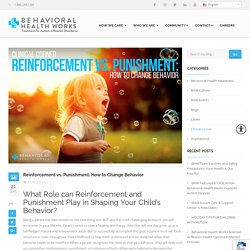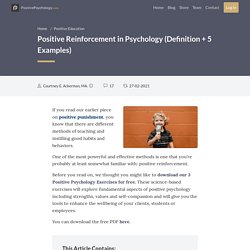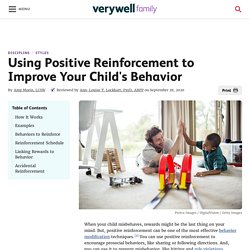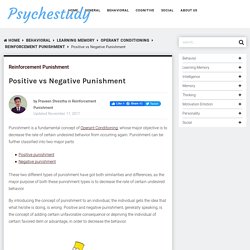

What are Reinforcement and Punishment. Reinforcement & Punishment. Reinforcement vs Punishment Psychology [Examples] Reinforcement and punishment are often used as parenting tools to modify children’s behavior.
![Reinforcement vs Punishment Psychology [Examples]](http://cdn.pearltrees.com/s/pic/th/reinforcement-punishment-183049524)
Let’s review the difference between positive reinforcement and negative reinforcement, and the difference in outcomes between them. The Difference Between Positive And Negative Reinforcement In behavioral psychology, reinforcement is the introduction of a favorable condition that will make the desired behavior more likely to happen, continue or strengthen in the future1. Because the favorable condition acts as a reward, reinforcement is a reward-based operant conditioning. Reinforcement vs. Punishment: Changing Behavior. Being a parent has been known as the best thing ever BUT also the most challenging endeavor you will encounter in your lifetime.

Parents strive to raise a healthy and happy child that will one day grow up as a full-fledged mature and independent adult. But to successfully accomplish this goal, a parent must set forth structure or rules throughout their childhood to help them understand and be realigned when their behavior needs to be modified. When a parent recognizes the need to change a behavior, they will likely end up using either reinforcement, punishment, or a mixture of both. When we’re helping to decrease the frequency of a child’s negative behavior, having the reinforcement or punishment methods in our toolkit can help you modify and implement the desired behavior.
Positive Reinforcement. Positive Reinforcement in Psychology (Definition + 5 Examples) If you read our earlier piece on positive punishment, you know that there are different methods of teaching and instilling good habits and behaviors.

One of the most powerful and effective methods is one that you’re probably at least somewhat familiar with: positive reinforcement. Before you read on, we thought you might like to download our 3 Positive Psychology Exercises for free. These science-based exercises will explore fundamental aspects of positive psychology including strengths, values and self-compassion and will give you the tools to enhance the wellbeing of your clients, students or employees. You can download the free PDF here. Negative Reinforcement. What is Negative Reinforcement? Negative Reinforcement: What Is It and How Does It Work? What is negative reinforcement?

Negative reinforcement is a method that can be used to help teach specific behaviors. With negative reinforcement, something uncomfortable or otherwise unpleasant is taken away in response to a stimulus. Over time, the target behavior should increase with the expectation that the unpleasant thing will be taken away. Read on to learn more about this type of learning. The relationship between behavior and consequences is part of a type of learning called operant conditioning.
For negative reinforcement to work, whatever is taken away must be taken away immediately after the behavior in question. Examples A person hears a loud alarm. Before behavior: Loud alarmBehavior: Person turns alarm offAfter behavior: No more annoying soundFuture behavior: Person pushes STOP every morning to quiet alarm Parents complain to their child when the child doesn’t clean their room.
Example of reinforcement. Examples of positive and negative reinforcement. Positive Punishment. Positive Punishment: What Is It And How It Works? - MomJunction. Positive Reinforcement - Tips for teaching and parenting. Using Positive Reinforcement.
Positive Punishment: What It Is, Benefits, and Examples. Positive punishment is a form of behavior modification.

In this case, the word “positive” doesn’t refer to something pleasant. Positive punishment is adding something to the mix that will result in an unpleasant consequence. The goal is to decrease the likelihood that the unwanted behavior will happen again in the future. This approach may be effective in certain circumstance, but it’s only one part of the equation. Guiding your child toward alternative behaviors that are more appropriate to the situation are also needed. Let’s take a look at positive punishment and how it compares with negative punishment and positive and negative reinforcement. All actions have consequences. For example, if your child eats whipped cream that has spoiled because they hid it under their bed, they’ll get a stomachache. These experiences are unpleasant at best. When choosing a punishment, think about punishing the behavior, not the child. Negative Punishment. What is Negative Punishment (Examples and Effectiveness)
In this article, we will review negative punishment, its definition, examples, and drawbacks.

American psychologist B.F. Skinner developed the theory of operant conditioning, which stated that a person or animal’s behavior could be increased or decreased by adding or removing appropriate stimuli after the behavior is exhibited. The difference between classical conditioning and operant conditioning is that classical affects unconscious behavior, while operant affects conscious behavior. What Is 'negative Punishment'? Definition And Real-World Examples. Negative punishment is a popular concept in parenting.

We'll explain what it is and how you can implement it with eight real examples. Your child is acting out, and it seems like nothing you say or do will curb their exasperating behavior. Sound familiar? No matter whether you're a parent, a babysitter, a nanny, or a day care worker, we’ve all been there -- scratching our heads, desperately racking our brains for the right solution to get our children to play nice. And with so many different parenting techniques out there, it's hard to figure out which one will work best for your child. Example of punishment. Using Positive Reinforcement to Improve Behavior. When your child misbehaves, rewards might be the last thing on your mind.

But, positive reinforcement can be one of the most effective behavior modification techniques.1 You can use positive reinforcement to encourage prosocial behaviors, like sharing or following directions. And, you can use it to prevent misbehavior, like hitting and rule violations. Positive reinforcement can also be an effective way to encourage and motivate your child to be responsible, do their chores, get along with their siblings, or complete their homework assignments without arguing. The Use of Reinforcement and Punishment in Shaping a Child's Behavior. Positive vs Negative Punishment - Psychestudy.
Punishment is a fundamental concept of Operant Conditioning, whose major objective is to decrease the rate of certain undesired behavior from occurring again.

Punishment can be further classified into two major parts These two different types of punishment have got both similarities and differences, as the major purpose of both these punishment types is to decrease the rate of certain undesired behavior. By introducing the concept of punishment to an individual, the individual gets the idea that what he/she is doing, is wrong. Positive and negative punishment, generally speaking, is the concept of adding certain unfavorable consequence or depriving the individual of certain favored item or advantage, in order to decrease the behavior. Summary of Reinforcement and Punishment.